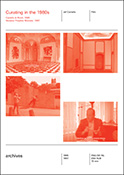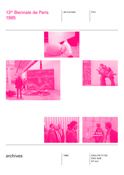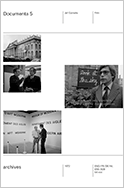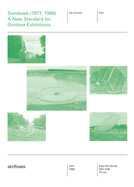
|
Documenta 4 de Jef Cornelis est le premier titre de la nouvelle collection
« Archives » dédiée aux pratiques curatoriales et aux manifestations ayant façonné l’histoire des expositions. Grâce à un matériel de référence (films, essais et documents), elle entend contribuer aux études, aujourd’hui grandissantes, consacrées à l’histoire curatoriale et du commissariat.
Organisée à Cassel entre juin et octobre 1968, documenta 4 est la dernière édition à être dirigée par Arnold Bode. En écho aux tumultes politiques et sociaux de cette année charnière, documenta 4 fut un lieu de débats et de controverses artistiques, politiques, esthétiques et générationnelles, mettant notamment à jour les tensions entre les scènes européenne et américaine. Le film rend compte de cette effervescence et donne la parole aux artistes, aux curateurs et au public, tout en offrant une vision inédite de la fabrique d’une telle exposition. Nous pouvons ainsi suivre Sol LeWitt élaborer Three-Part Variations, Joseph Beuys installer Raumplastik, Martial Raysse débattre du rôle de l’artiste, Harald Szeemann défendre le concept de musée, ou Edward Kienholz expliquer Roxys, assis dans l’un des canapés de son installation.
Le film Documenta 4 présente les œuvres des artistes suivants : Getulio Alviani, Carl Andre, Shusaku, Arakawa, Arman, Joseph Beuys, Louis Cane, César, Christo, Chryssa, Domenico Gnoli, Raymond Hains, Richard Hamilton, Al Held, Robert Indiana, Allen Jones, Ed Kienholz, Sol LeWitt, Roy Lichtenstein, Richard Lindner, Morris Louis, Robert Malaval, Jos Manders, Escobar Marisol, Robert Morris, Claes Oldenburg, Walter Pichler, Ramon, Roger Raveel, Robert Rauschenberg, James Rosenquist, Lucas Samaras, George Segal, Zdenek Sykora, Daan van Golden et Tom Wesselmann. Il rend compte d’entretiens avec les artistes, commissaires d’expositions, directeurs d’institutions et critiques d’art suivants : Arman, Arnold Bode, Joseph Beuys, César, Christo, Jean Dypreau, Otto Hahn, Allen Jones, Ed Kienholz, Jean Leering, Sol LeWitt, Julio Le Parc, Jan van der Marck, Martial Raysse, Robert Rauschenberg, Denise René, Pierre Restany, Michael Sonnabend, Harald Szeemann, Dan Van Severen et John Weber.
Jef Cornelis a travaillé comme réalisateur à la VRT, la radio et télévision belge néerlandophone. En 35 ans, il a réalisé plus de 200 films sur l’architecture, les arts plastiques et la littérature. Son œuvre vidéo est distribuée par Argos–Centre for Art and Media, Bruxelles.
Yves Aupetitallot est historien de l'art, commissaire d'exposition et directeur du Magasin, Grenoble.
Documenta 4 by Jef Cornelis is the first title of the new “Archives” series, which is dedicated to landmark exhibitions and curatorial practices, and which provides reference material and moving images to a growing field of research, that of curatorial studies and exhibition history.
Held in Kassel between June and October 1968, documenta 4—the last to be directed by Arnold Bode—was plagued by controversy and debate: artistic, political, generational, and aesthetic conflicts, as well as tensions between European and American art were some of the issues that affected this edition, echoing the social and political upheavals that were taking place elsewhere at the same time. The film reflects this effervescence, giving voice to the artists, curators, and audience, but also offers a unique approach to an exhibition in progress. We can watch Sol LeWitt constructing Three-Part Variations, Joseph Beuys installing Raumplastik, Martial Raysse talking about the role of the artist, Harald Szeemann defending the concept of the museum, Edward Kienholz explaining his work from inside his Roxys installation, and so on.
The film Documenta 4 presents the works of the following artists: Getulio Alviani, Carl Andre, Shusaku Arakawa, Arman, Joseph Beuys, Louis Cane, César, Christo, Chryssa, Domenico Gnoli, Raymond Hains, Richard Hamilton, Al Held, Robert Indiana, Allen Jones, Ed Kienholz, Sol LeWitt, Roy Lichtenstein, Richard Lindner, Morris Louis, Robert Malaval, Jos Manders, Escobar Marisol, Robert Morris, Claes Oldenburg, Walter Pichler, Ramon, Roger Raveel, Robert Rauschenberg, James Rosenquist, Lucas Samaras, GeorgeSegal, Zdenek Sykora, Daan van Golden, and Tom Wesselmann. It documents interviews with the following artists, curators, institution directors, and art critics: Arman, Arnold Bode, Joseph Beuys, César, Christo, Jean Dypreau, Otto Hahn, Allen Jones, Ed Kienholz, Jean Leering, Sol LeWitt, Julio Le Parc, Jan van der Marck, Martial Raysse, Robert Rauschenberg, Denise René, Pierre Restany, Michael Sonnabend, Harald Szeemann, Dan Van Severen, and John Weber.
Jef Cornelis mainly worked for VRT, the Flemish Belgian national television. Over 35 years he realized more than 200 films on architecture, literature, and the arts. His video work is distributed by Argos–Centre for Art and Media, Brussels.
Yves Aupetitallot is an art historian, curator, and director of Le Magasin, Grenoble.
(Photo Credits: © VRT/Courtesy ARGOS, Brussels)
|






